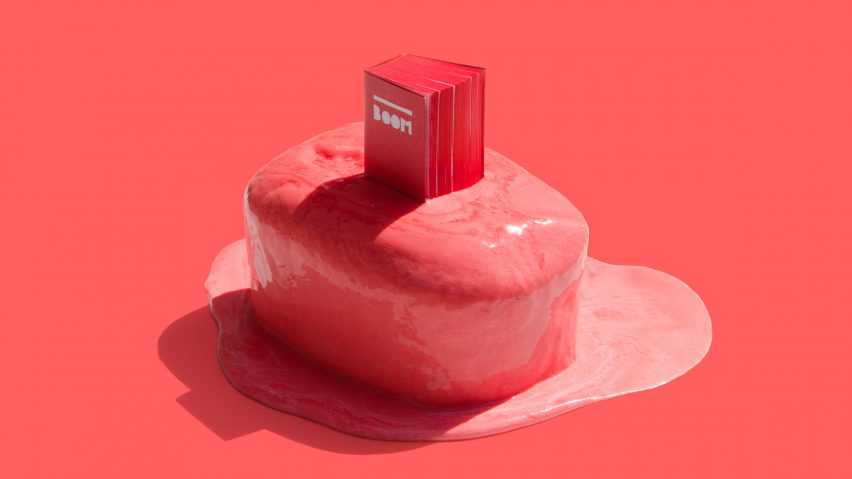New York-based designer Ben Denzer has attracted a fleet of followers on Instagram with his ice cream photography series, which see tasty frozen treats matched with aesthetically pleasing books.
Denzer told Dezeen that the project started as a parody of so-called "bookstagrammers" – Instagram influencers that publishers send titles to, to be photographed and Instagrammed.
After choosing books with beautiful or interesting covers, Denzer strategically places ice cream, or other frozen desserts, on top of the volumes, and captures the melting results.
Denzer launched his Instagram account in May 2016 under the name @ice_cream_books – it now has a following of around 22,000 people.
In one image, David Hockney and Martin Gayford's bright blue volume of A History of Pictures is topped with frozen watermelon balls, while in another a large volume on the Bauhaus is supported by four stilts made from slowly collapsing Choc Ices.
The photography series is the product of Denzer's fascination with the book as an object. He aims to shift the perception of books as pure content, and display them in a new light.
"Books are fascinating to me because they are both object and content simultaneously. But to most readers, content overwhelms any understanding of the book as a physical object," Denzer told Dezeen.
"If a book's identity as an object is acknowledged, it's typically only in a quasi-sacred way, as a necessarily pristine and blank container," he continued.
"Don't write in the margins or dog ear pages. If you spill ice cream on a book's cover, people get upset. This forcing of a reader to acknowledge the object quality of books interested me."
Almost all of the ice cream and book pairings are specifically related, either visually, conceptually, or textually, to each other.
Visual connections see Denzer strategically place ice cream scoops to appear as if a hand is reaching for them, like in the autobiography of Gucci Mane, or to look like a football being kicked by a girl in Tamara Shopsin's Arbitrary Stupid Goal.
More conceptual links include four rectangular sandwich ice creams stuck to the front of a book of Donald Judd's Writings, to imitate the American artist's Untitled sculpture.
Denzer also topped the Museum of Capitalism with a golf-leaf-covered ice cream. "I think an ice cream shop selling edible gold leaf placed on their soft serve is a good visual extreme of capitalism," he explained.
The designer's attempt to highlight the object quality of books in this photography series is less invasive than his previous projects, which have seen him physically nail books shut, drill holes in them, and attach bolts, wheels, ball bearings, coat hangers and brackets to them.
"If a book rolls away from you, you realise it’s an object. If a book is sharp, you realise it’s an object. If a book has holes through it, you realize it’s an object," he said.
While his Ice Cream Books project was born from a similar place, he wanted to create a look that he could keep consistent while also being compositionally interesting, colourful, and warm.
Denzer takes all the photographs outside in direct sunlight – adding a tighter time pressure to the already-melting desserts. He shoots each composition against a white backdrop, and adds in the vibrant background colours afterwards via photoshop.
"This lets me be mobile," he explained. "I can photograph right outside an ice cream shop and not have to worry about running a melting cone to a studio. It also keeps me at the whim of the weather."
He describes this process of photographing on the street as a performance saying: "Occasionally people will comment as they walk by or yell from a car."
"Sometimes it's positive, sometimes it's negative," he said. "Interestingly, people on the street tend to be more concerned with the melting ice cream, while people on Instagram are more worried about the condition of the books."
"I tend to keep photographing until I'm forced to stop, because you never know in the moment what the best image will be, so the temporal element of the melting is actually helpful in keeping things efficient," he continued.
Born and bred in Kansas, Denzer studied Architecture and Visual Arts at Princeton. His interest in photography stemmed simply from documenting the things he makes, such as masking tape sculptures.
"In this sense," he said. "I feel like my photographs try to be somewhat neutral, letting the subject of the photograph do most of the heavy lifting."
Photographer Stephan Zirwes also shot a summery photography series, using drones to capture aerial views of public swimming pools, in a bid to make people appreciate the value of free swimming facilities.

